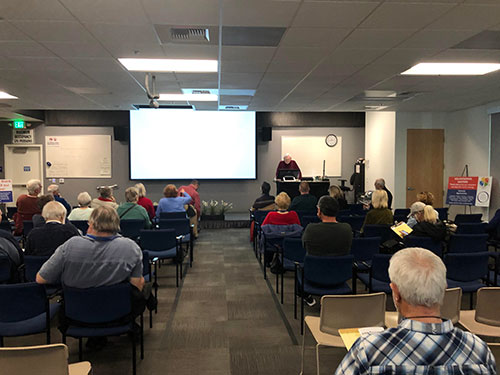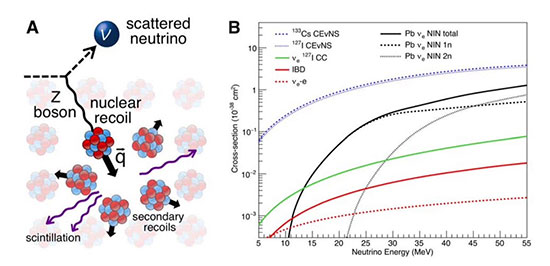Well this week we can talk about an interesting discussion of coherent neutrino scattering and impact on dark matter searches, but first,
you might want to check your calendar for when the launch of the Delta IV Heavy rocket from Vandenberg, which has been scrubbed at least twice, is actually going to happen. For those of you in the OC area the launch site is at about 290 degrees azimuth. I have been all set up in the past, with camera and tripod pointing in that direction, and the launch was scrubbed at T - 7 seconds. Maybe this next time it will work out and the clouds will stay away and we should have a great view here in OC. If you want to see some previous photos from the Falcon 9 launch, as seen from Vandenberg, check out the blog post of October 8, 2018. Also, in our blog post of February 8, 2018, you can catch up on the story of when we viewed the Falcon Heavy launch, with Elon's red Tesla as payload, from the Kennedy Space Center.
Ok, back to current events, this week I attended a lecture at the Osher Lifelong Learning Institute (OLLI) on the science breakthroughs of 2017. Dr. John Bush, presented the first of a two part lecture based on topics identified by Science magazine. During the intermission, I recognized that Science Guy and Part time Texan, Jay was also another attendee in the audience. Good to see you there, Jay!
 |
| Dr. John Bush gets ready for OLLI lecture on Science Breakthroughs in 2017 (Source: Palmia Observatory) |
The identified science breakthrough especially applicable to me and probably to this audience of physicist wannabes and astronomer wannabes, was the breakthrough in coherent neutrino scattering. This concept has been recognized for decades now, but it is just at this time that the small force on a whole nucleus, not just scattering from a single proton or neutron, can be detected. The nuclear recoil, after a nucleus has been struck by a neutrino, excites the nucleus and it emits a photon it falls back to the lower energy state.
I found this breakthrough very interesting and I couldn't recall remembering much about it at the time it was announced in 2017, so I had to do some more background reading on the topic. The figure below illustrates the concept of an neutrino striking an atomic nucleus and scattering and the nuclear recoil, because of conservation of momentum, can be measured as the nucleus relaxes back to its ground state.
Note the big improvement in cross-section sensitivity, especially for neutrino energies below say 15 MeV. The sensitivity increases by a factor of a thousand or so or at least a couple of hundred. This means that neutrino detection in this energy range is possible with very small detectors, not like the current versions that require hundreds to thousands of tons of detector liquid.
 |
| Coherent Elastic Neutrino-Nucleus Scattering yields big sensitivity improvements (Source: COHERENT Collaboration) |
This photo from Science Daily shows the "world's smallest neutrino detector."
 |
| "World's Smallest Neutrino Detector" (Source: Courtesy Science Daily) |
So, where do you get some neutrinos to test out all of these new ideas? You can get some from the sun and from supernova and from nuclear reactors, but it seems the best controllable source of neutrinos is from the Spallation Neutrino Source (SNS). The SNS directs a high intensity beam of protons at a mercury target and the spray of resulting neutrons is used for research. At the same time, neutrinos are also produced and they can be used in controlled experiments. My reading up on this source indicated that the neutrino source can be pulse modulated at 60 Hz, so any experiments can compare the influx of neutrinos at the rate and compare it to the background rate. Pretty neat!
 |
| The Oak Ridge Spallation Neutron Source makes plenty of neutrinos too! (Source: Oak Ridge National Laboratory) |
The image below shows the SNS and the "neutrino alley" located some 2--30 meters away. This distance is filled with concrete and gravel which minimizes the proton flux from the SNS and the tunnel overburden reduces some of the cosmic ray background noise.
 |
| Neutrino experiments at Spallation Neutron Source at Oak Ridge Lab (Source: COHERENT Collaboration) |
So this increased sensitivity is great for doing neutrino research, but the coherent scattering of neutrinos has typically not considered a good thing for those searching for dark matter detection. It turns out that dark matter detection techniques have improved so much that their lower limit of detection is now approaching the floor of background noise, which is generated by Coherent Neutrino-Nucleus Scattering (CNNS) by background neutrinos, and therefore maybe not an indication of dark matter annihilation and detection. Check out this sensitivity plot and areas where dark matter models have been excluded and note how the bottom of the exclusion curve is starting to bump into the CNNS region.
 |
| XENONIT deepens dark matter exclusion zone almost to CNNS levels (XENONIT Collaboration) |
 |
| Darn Clouds! Ok, ok, at least we got a beautiful sunset! (Source: Palmia Observatory) |
Until next time,
Resident Astronomer George
If you are interested in things astronomical or in astrophysics and cosmology
Check out other postings on this blog at www.palmiaobservatory.com

No comments:
Post a Comment